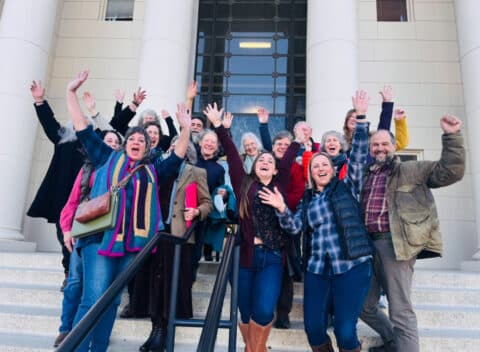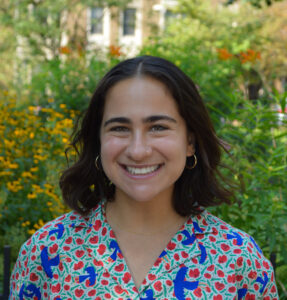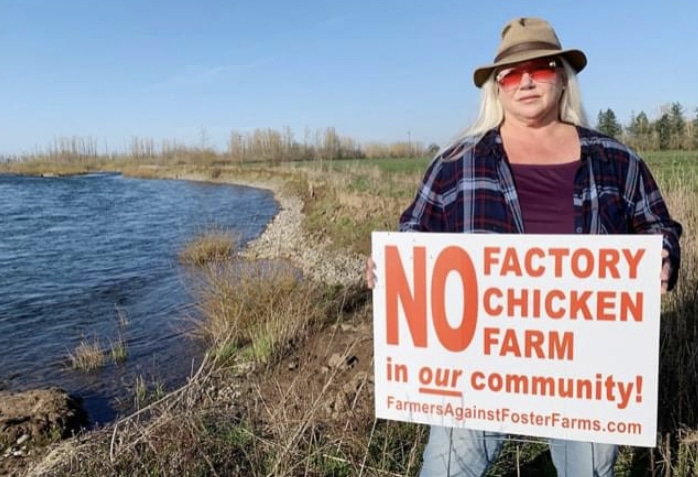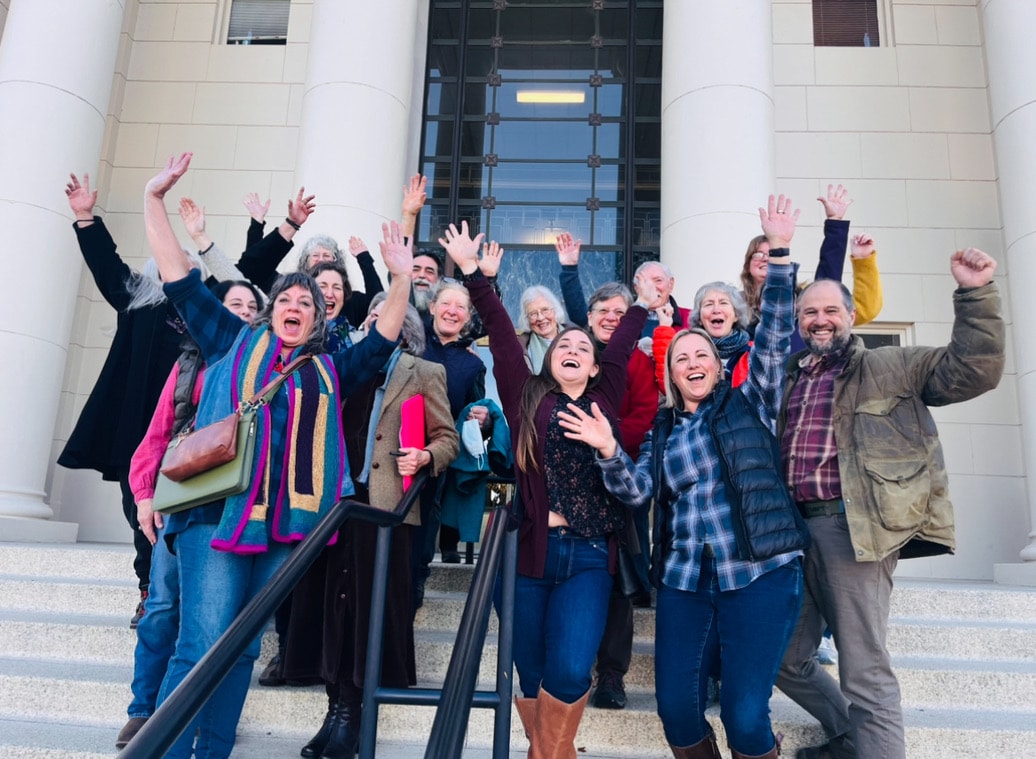News
More Than 71% of Americans Oppose Common Factory Farming Practices
Factory Farms•5 min read
Solutions
“These operations are not farms. They’re factories.”


Words by Nina B. Elkadi
Teresa Mitchell Clausen was almost finished with her shift at a local farm store when a customer came in looking to buy a fruit tree. During their exchange, he said he was a land scout for Foster Farms, and began telling her about the five-year plan for industrial chicken operations in the area, one of which Clausen realized would be built 350 feet from her then-home. “What about the little red farmhouse across the irrigation ditch?” she remembers asking him. “Oh, what is that? One or two people? They obviously don’t have any money,” Clausen recalls him saying. “We don’t have to worry about them.”
She didn’t know it at that moment, but the exchange kicked off a five-year battle to oppose the nearby industrial poultry operation, with Clausen and two of her neighbors eventually co-founding Farmers Against Foster Farms. “He didn’t know he was speaking to someone who lived there,” Clausen tells Sentient. Community-driven initiatives like this one are happening across the country. As these initiatives mount similar legal and political battles to stop factory farms before they can be constructed, Linn County could be a model to follow.
Oregon has always been Clausen’s home, and she understands the value of farming in the state. As a teenager, she worked in the fields, which helped shape her vision of what a healthy food landscape could look like.
“The thing about being a farmer is that your name meant something,” she says. “You were someone who tilled the soil, harvested the land, fed your community, provided livestock, row crops. It was an essential part of who we are.” Now, she says, corporate agricultural operations are coming in, making promises and “pulling the heartstrings of farmers,” eventually manipulating them into participating in a large-scale system where they are just a “pawn in the game.”
The farm store conversation took place during the beginning of the COVID-19 pandemic. Clausen, who was wearing a mask, was able to hide her emotions. When she got home, she began researching the options, determined to find a way to stop construction. Clausen became connected with her neighbor, who lived 12 miles away, Kendra Kimbirauskas, who was also committed to keeping their neighborhood free from factory farms.
Kimbirauskas is no stranger to agriculture either, as she happens to also be the Senior Director of Agriculture and Food Systems at the State Innovation Exchange, a non-profit legislative group. She and her husband farm 70 acres in rural Oregon, where they raise beef cattle, pigs and goats on pasture. She grew up on a Midwest dairy farm.
The permit that ended up being filed was for a 3.5 million chicken farm that would have been situated less than 500 feet from the Cascade-fed North Santiam River, a “stronghold for native fish in Oregon’s Willamette Valley,” and a natural salmon spawning habitat.
“People love that river,” Kimbirauskas tells Sentient. “People use it for irrigation, they recreate on it, and it serves as a drinking water source for some downstream communities.” The area also receives a lot of rain, at 37 to 80 inches per year. (For comparison, rainy Seattle receives an average of 37.13 inches per year.) The Willamette Valley is generally flat, she explains. When it rains a lot, “there’s literally nowhere for the rain to go. It creates these river systems above ground, across fields. And these facilities were going to be smack dab in the middle of these fields.”
“These operations are not farms. They’re factories,” Kimbirauskas says, as the potential for pollution illustrates. An industrial chicken farm can produce 4,500 tons of poultry waste each year, and its proximity to the river raised concerns about the impact of waste there.

Concentrated animal feeding operations (CAFOs) like these house hundreds, to thousands, to — in this case — millions of animals packed inside barns. The animals typically live out their days crammed body-to-body, in some cases without being exposed to sunlight until slaughter. All of those animals also defecate, and the waste adds up. According to a 2024 report from Food and Water Watch, livestock operations in the United States produce 941 billion pounds of manure each year.
The proposed facility on the Santiam River, J-S Ranch, would be a producer for Foster Farms, one of the largest chicken integrators on the West Coast (that also happens to be facing lawsuits elsewhere in the country). Concerned about their water quality, air quality and traffic on the roads, “a core group of women farmers” got together to form Farmers Against Foster Farms, the group that would eventually become one of the plaintiffs in a case against the operation.
Kimbirauskas says that “farmers were out front” in this fight.
“Water is a big deal in the western part of the United States,” she says. “People kill each other over water.” Without water, there cannot be farming.
In Oregon, Kimbirauskas describes how an “old homestead law” governed the land. If a property owner was using their well water for livestock, they did not need special permission to do that. Back when people were homesteading and raising a few cattle, this was not a huge concern. But whether for ten cows or 100,000, Oregon law said that livestock watering was exempt from limitations.
“When these chicken operations came in, that was a huge threat to the local agriculture that was here already,” Kimbirauskas says. “They were just basically going to put a straw in the ground and take as much water as they needed to water these chickens.”
Kimbirauskas has a cautionary note for other community groups: when fighting a CAFO, it is easy to “panic” and start focusing on all of the problems. There are animal welfare issues, water issues, air issues and labor issues, to name a few. To stay focused, she says the groups decided to target the law. They figured out how CAFOs were regulated and looked into how to reform that regulation.
“You have to stay focused on what the laws allow for you to organize around,” she says, and zero in on “where there’s some potential to have some pressure to stop these things from moving forward.”
When the J-S Ranch proposal came to light, anti-CAFO advocates in Oregon had just finished another lengthy battle. Staff attorney for Center for Food Safety Amy van Saun tells Sentient that in 2018, multiple non-profit advocacy groups, including Food & Water Watch and Friends of Family Farmers, successfully pressured the Oregon government to revoke the permit of a mega-dairy in Boardman, a city also located nearby the Columbia river.
After that win, van Saun tells Sentient, the group wanted to look bigger: How would they ensure that Oregon did not become a hot-spot for CAFOs, especially as operators look to leave behind stricter regulations and enforcement in states like California?
Oregon would need to change its laws.
In Oregon, due to an exemption in the Groundwater Act of 1955, factory farms could extract unlimited quantities of groundwater. Additionally, counties or cities did not have the ability to require CAFOs be built a certain distance away from other properties. Clausen, who now works for the Socially Responsible Agriculture Project, a non-profit advocacy group focused on protecting communities from factory farms, tells Sentient that “integrators look for loopholes.”
To stop J-S Ranch, as well as other new CAFOs, those laws had to change.
Their advocacy ultimately resulted in the passage of Senate Bill 85, which changed the rules regarding factory farms. It requires stricter water quality requirements for large CAFOs to obtain a permit, gives local governments the authority to establish land parcel setback limits for new CAFOs and temporarily pauses new or expanded water rights permits for CAFOs using groundwater for livestock watering. When the bill went into effect in July 2023, it gave the J-S Ranch protestors something big to work with.

“You can pass laws that have this trickle-down type of effect,” van Saun says. “Operations can be blocked, either by the law automatically, or, in this case, having attorneys be able to come in and enforce that law.”
In 2022, the Linn County plaintiffs filed a lawsuit challenging J-S Ranch’s initial water permit. In April 2024, the Oregon Department of Agriculture withdrew J-S Ranch’s Water Pollution Control Facility permit. The Department of Agriculture issued a new permit later that year requiring soil sensors to monitor discharges.
But after SB 85 was passed in 2023, the plaintiffs (Christina Eastman, in her individual capacity; Farmers Against Foster Farms; Friends of Family Farmers, an Oregon nonprofit corporation; and Willamette Riverkeeper, an Oregon nonprofit corporation), had grounds to petition the National Pollutant Discharge Elimination System (NPDES) permit issued to J-S Ranch.
Represented by the Center for Food Safety and Sugerman Dahab, an Oregon-based law firm, the plaintiffs argued that J-S ranch should be considered a “new CAFO,” triggering additional requirements, such as those now defined in SB 85, and the newly created one-mile setback in Linn County (where J-S Ranch would be) for new large poultry CAFOs. This facility would be less than 1,000 feet from a nearby residence. Thus, their 2024 NPDES permit should be considered unlawful.
On May 19, 2025, approximately five years after their advocacy began, the groups were delivered a victory: Judge Rachel Kittson-MaQatish ruled that the Oregon Department of Agriculture’s NPDES permit for the 3.5 million chicken factory farm was, in fact, unlawful.
Sprinkled across the United States — more often than is being reported — rural residents are experiencing similar threats to their water health, soil health and community by way of large-scale industrialized animal operations. Often, these residents are farmers themselves.
Kimbirauskas has some advice for communities facing similar fights. First, pace yourselves. These fights are marathons, not sprints, she says.
Regardless of political or personal differences, the community can unite around a shared goal. “People were not divided along political ideologies. There were Republicans, Democrats, everything in between, all coming together to say, this is not right for this area, or frankly, any area,” she says.
Finally, no one knows their community better than local residents, Clausen says, and at the end of the day, residents need to be the core of any opposition.
“You don’t have to be a politician to make a permanent change,” Clausen adds. “There are other like-minded people out there, and sometimes they can borrow your courage once you step out, and then they’ll come with you.”